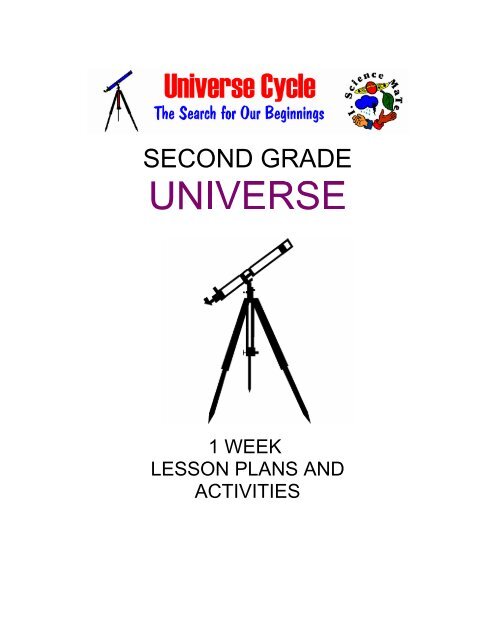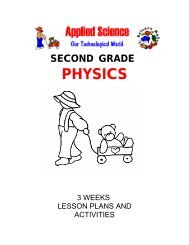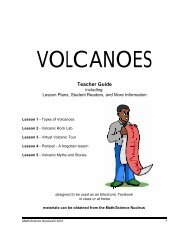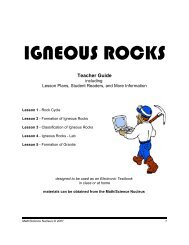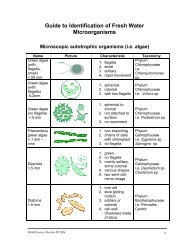SECOND GRADE - Math/Science Nucleus
SECOND GRADE - Math/Science Nucleus
SECOND GRADE - Math/Science Nucleus
Create successful ePaper yourself
Turn your PDF publications into a flip-book with our unique Google optimized e-Paper software.
<strong>SECOND</strong> <strong>GRADE</strong><br />
1 WEEK<br />
LESSON PLANS AND<br />
ACTIVITIES
UNIVERSE CYCLE<br />
OVERVIEW OF <strong>SECOND</strong> <strong>GRADE</strong><br />
UNIVERSE<br />
WEEK 1.<br />
PRE: Discovering stars.<br />
LAB: Analyzing the geometric pattern of constellations.<br />
POST: Exploring myths about the constellations.<br />
SOLAR SYSTEM<br />
WEEK 2.<br />
PRE: Comparing the 9 planets of our Solar System.<br />
LAB: Comparing the distance between planets.<br />
POST: Exploring terrestrial and gas planets.<br />
EARTH<br />
WEEK 3.<br />
PRE: Comparing the Earth and the Moon.<br />
LAB: Exploring the characteristics of the Earth's surface.<br />
POST: Exploring the features of the Moon.<br />
WEEK 4.<br />
PRE: Contrasting different types of maps.<br />
LAB: Exploring longitude and latitude.<br />
POST: Comparing maps and globes.<br />
GEOGRAPHY<br />
<strong>Math</strong>/<strong>Science</strong> <strong>Nucleus</strong> © 1990, 2001 2
UNIVERSE CYCLE - UNIVERSE (2)<br />
PRE LAB<br />
OBJECTIVES:<br />
1. Discovering stars.<br />
2. Identifying and comparing constellations.<br />
VOCABULARY:<br />
constellation<br />
galaxy<br />
light year<br />
nebula<br />
star<br />
universe<br />
MATERIALS:<br />
Celestial Globe Model<br />
The Big Dipper by F. Branley (Harper)<br />
Glow in the Dark Night Sky Book by C. Hatckett (Random)<br />
BACKGROUND:<br />
Students identify Orion and Ursa<br />
Major.<br />
The Universe is a vast space of unknown dimensions. The Milky Way is our<br />
address in the Universe. Our Sun is only one small component amongst the other billions<br />
of stars in our galaxy, the Milky Way. The Solar System is a group of 9 planets that<br />
revolve around the Sun.<br />
We see objects in the night sky because they are either generating or reflecting<br />
light. While these objects also shine or reflect light during the day, we generally cannot<br />
see them because they are much dimmer than the bright light emitted by the nearby Sun.<br />
Most of the light we see at night comes from within our own galaxy, the Milky Way.<br />
Some points of light, however, are from other galaxies or nebulas, which are glowing<br />
clouds of gas within our galaxy.<br />
Most of the stars and galaxies we see at night are very far away. This is difficult for<br />
humans to comprehend. We do not even measure the distance in kilometers; instead, we<br />
use light years. Light travels about 300,000 km per second, faster than anything we know.<br />
A light year is the distance light can travel in one year, an almost unimaginable number.<br />
Multiply the number of seconds in one year (31,557,000) times 300,000 km/yr. This results<br />
in a distance of 9,467,100,000,000 km per year, or about 9.5 quadrillion kilometers/year.<br />
When ancient people looked in the night sky, they noticed groups of stars which<br />
<strong>Math</strong>/<strong>Science</strong> <strong>Nucleus</strong> © 1990, 2001 3
formed images of animals, gods, and heroes. In the silence and darkness, ancient<br />
humans started to tell stories to one another for entertainment. The students will look at<br />
two constellations in the lab: Orion and the Big Dipper.<br />
Orion was a hunter who was killed by a giant scorpion. He was placed in the sky<br />
but was still chased by the scorpion, which is found in a constellation (Scorpio) on the<br />
other side of the sky. When Orion is visible, the scorpion is below the horizon. When the<br />
scorpion rises, Orion sets, so that they are never visible at the same time. The Big Dipper<br />
is actually part of the Ursa Major (Big Bear) constellation, and represents a cup with a<br />
long handle.<br />
These points of light in the sky, and the shapes they represented, were also<br />
important for traveling at night and for determining the time of the year. The<br />
constellations, as they are now called, helped to guide the early people in many ways.<br />
The constellations are groupings of points of light, as seen from the Earth. Some<br />
of the points of light may represent far away galaxies, but the majority represent individual<br />
stars. There are 88 constellations that have been part of a historical written record.<br />
There are many other cultures who had terms for patterns of light, but unfortunately their<br />
record was not passed on through generations like the European/North African stories.<br />
These constellations will help students orient themselves in the nighttime sky.<br />
PROCEDURE:<br />
1. Show students a celestial globe or a<br />
picture of the night sky. In the celestial globe<br />
the Earth is in the center. Tell students that if<br />
they are standing on the Earth and looking up<br />
they will see the stars on the other clear globe.<br />
If you are standing in the United States the stars<br />
you see in the sky are different than if you are<br />
standing on Australia. There is many directions<br />
to the Universe, depending on where you are<br />
looking.<br />
2. Tell the students that we cannot see<br />
all the points of light of the night sky that are shown in many books (as shown the Glow<br />
in the Dark Night Sky Book) because of city lights and haze. Ask the students to name<br />
things that they may see in the night sky (moon, stars, satellites, planets, and galaxies).<br />
Explain that only stars and galaxies shine, or emit light; the other sky objects all reflect<br />
light.<br />
3. You may want to ask students, how fast does light travel? They may never have<br />
thought about this question before. Switch the light on and off and ask them how long it<br />
takes the light to move from the bulb to the ground. Students won't be able to time such<br />
an event. Explain the speed of light and light years. You may want to compare the speed<br />
<strong>Math</strong>/<strong>Science</strong> <strong>Nucleus</strong> © 1990, 2001 4
of light with the speed of a car on the freeway which is about 80 km per hour or 1.33 km<br />
per minute or .02 km per second. Light is fast!<br />
4. Ask the students which objects make their own light. Stars generate light<br />
because they are giving off energy. Ask them which star is closest to us. If they do not<br />
know, explain that it is our own Sun. Tell them that stars are like our Sun, but very far<br />
away. Show pictures of different types of stars, and say that our Sun is only a medium size<br />
star.<br />
5. Explain that patterns of stars are called constellations, and that there are<br />
stories about some of these groups. Astronomers now use 88 constellations to help<br />
divide the Universe into areas. Scientists use these to help locate components in that<br />
sector. So the term constellations can mean a historical grouping of stars with stories and<br />
myths associated with them, or as a way to locate an area on a Celestial Globe.<br />
6. Have the students read, “The Big Dipper.”<br />
<strong>Math</strong>/<strong>Science</strong> <strong>Nucleus</strong> © 1990, 2001 5
UNIVERSE CYCLE - UNIVERSE (2)<br />
LAB<br />
OBJECTIVES:<br />
1. Comparing and contrasting constellations.<br />
2. Analyzing the geometric patterns of constellations.<br />
VOCABULARY:<br />
constellation<br />
galaxy<br />
star<br />
MATERIALS<br />
Constellation tubes (students make)<br />
Inflatable Celestial Globes<br />
BACKGROUND:<br />
Students make a constellation<br />
telescope.<br />
Recognizing the constellations in<br />
the night sky usually requires one person pointing out the geometric configuration to<br />
another. Few people can see all the constellations because they cannot find some of the<br />
key stars. For example, the key star group in Orion is to locate the three stars of Orion’s<br />
belt For the Big Dipper (part of the Ursa Major constellation), the four points of the bucket<br />
help locate it in the sky.<br />
Students should understand that constellations are not scientific groupings, but are<br />
a way astronomers can locate celestial objects from Earth. Not all the points of light in<br />
constellations are stars; some are far away galaxies.<br />
Describe galaxies as a big bunch of stars. The Milky Way is the galaxy that we are<br />
in and contains all the stars we can see. The faint streak across the night sky (a purple<br />
streak on the Inflatable Celestial Globes) is caused by looking into the center of the Milky<br />
Way.<br />
PROCEDURE:<br />
1. This activity concentrates on two constellations in the night sky, Orion and the<br />
Big Dipper. These two constellations were chosen because they are visible in the night<br />
sky if you are doing these labs in the later part of the school year. Note that the Big Dipper<br />
is not a constellation, but part of the Ursa Major constellation, as shown on the dot to dot<br />
exercise. Increasing students geometric recognition of patterns can help them see the<br />
<strong>Math</strong>/<strong>Science</strong> <strong>Nucleus</strong> © 1990, 2001 6
patterns in the night sky. However, the night sky is not available during the day so you<br />
need to make Constellation Tubes, which bring the night sky to the classroom.<br />
Direct students to complete the dot to dot exercise on Orion and Ursa Major. This<br />
will guide them to see the objects in the constellation tubes.<br />
2. The instructions below guide you in making Constellation Tubes with the<br />
students.<br />
CONSTELLATION STATIONARY TUBE<br />
MATERIALS:<br />
long cans with plastic lids (e.g., potato chip or tennis ball cans)<br />
matte black paint (optional)<br />
tag board<br />
margarine tub with lid<br />
Cut both ends of the can, making a tube that you can look through. Paint the tube<br />
inside and out with matte black spray paint. Cut circles the size of the ends of the tube<br />
from the black tag board or heavy cardboard. The plastic lid should be used to keep the<br />
cardboard in place.<br />
Punch holes to create the constellations Orion and Big Dipper(Ursa Major) as<br />
shown below.<br />
Big Dipper<br />
Orion (Ursa Major)<br />
Note that you can make any constellation by punching different patterns in the tag board.<br />
Assemble the materials together as shown above. You have now made a child's<br />
telescope of the constellations.<br />
3. Let children look into the open end of the Constellation Tube, and point the end<br />
with the tag board circles towards a window or light. They should see the star pattern in<br />
their "telescope".<br />
<strong>Math</strong>/<strong>Science</strong> <strong>Nucleus</strong> © 1990, 2001 7
4. Give the students either a paper "geoboard" (see enclosed master) or real<br />
geoboards. Have the students trace the patterns of the stars onto paper or the geoboards<br />
in the correct geometric relationship. You may want to demonstrate how to trace objects<br />
by putting 2 dots on the board and tell the students<br />
to copy them, as shown in the diagram to the right.<br />
Tell the students to make sure they place the dots in<br />
a similar pattern. Add a third dot and have them<br />
place the dot position on their paper. Again make<br />
sure they see the position. Give them only the two<br />
templates of Orion and the Big Dipper. You may want to add other templates but do not<br />
give them too many at a time. The goal is for them to be able to recognize Orion and the<br />
Big Dipper in the night sky. Please remember this only works in the Northern Hemisphere.<br />
<strong>Math</strong>/<strong>Science</strong> <strong>Nucleus</strong> © 1990, 2001 8
UNIVERSE CYCLE - UNIVERSE (2) LAB<br />
ORION<br />
<strong>Math</strong>/<strong>Science</strong> <strong>Nucleus</strong> © 1990, 2001 9
UNIVERSE CYCLE - UNIVERSE (2) LAB<br />
BIG DIPPER(within the URSA MAJOR)<br />
<strong>Math</strong>/<strong>Science</strong> <strong>Nucleus</strong> © 1990, 2001 10
UNIVERSE CYCLE - UNIVERSE (2) LAB<br />
GEOBOARD<br />
<strong>Math</strong>/<strong>Science</strong> <strong>Nucleus</strong> © 1990, 2001 11
UNIVERSE CYCLE - UNIVERSE (2)<br />
POST LAB<br />
OBJECTIVE:<br />
1. Exploring myths about the constellations.<br />
2. Finding information on the constellations.<br />
VOCABULARY:<br />
constellation<br />
myths<br />
MATERIALS:<br />
paper and pencil<br />
Internet<br />
Glow in the Dark Night Sky Book<br />
worksheet<br />
BACKGROUND:<br />
Students write a paragraph on<br />
one of the constellations.<br />
Constellations are groupings of stars and galaxies that we see from Earth.<br />
Remember that constellations are apparent associations of celestial objects that are many<br />
light years away. Many of these objects themselves are very far from each other.<br />
The zodiac is an imaginary belt in the heavens, usually between 18 degrees of the<br />
celestial equator, that encompasses the apparent paths of the principal planets of the<br />
Solar System, except for Pluto. Within this belt there are 12 constellations that are<br />
referred to as the Constellations of the Zodiac. They are used when we talk about the<br />
astrological sign we were born under. For example, if you are born at the end of January<br />
to mid February, your sign is Aquarius, the water bearer.<br />
The list of the 88 constellations is fun to review. These constellations are used to<br />
divide the heavens into units which help us locate other objects. It also tells something of<br />
the ancient peoples who looked up into the night time sky. In order to see animals such<br />
as elephants and lions in the sky, these animals must have been common in everyday life.<br />
The stories behind the constellations were created by “story tellers” within tribes of people.<br />
<strong>Math</strong>/<strong>Science</strong> <strong>Nucleus</strong> © 1990, 2001 12
ANDROMEDA (Princess)<br />
ANTLIA (Air Pump)<br />
APUS (Bird of Paradise)<br />
AQUARIUS (Water Bearer)<br />
AQUILA (Eagle)<br />
ARA (Altar)<br />
ARIES (Ram)<br />
AURIGA (Charioteer)<br />
BOOTES (Herdsman)<br />
CAMELOPARDALIS (Giraffe)<br />
CANCER (Crab)<br />
CANES VENATICI (Hunting Dog)<br />
CANIS MAJOR (Big Dog)<br />
CANIS MINOR (Little Dog)<br />
CAPRICORNUS (Sea Goat)<br />
CARINA (Keel of Ship)<br />
CASSIOPEIA (Queen)<br />
CENTARUS (Centaur)<br />
CEPHEUS (King)<br />
CETUS (Whale)<br />
CHAMAELEON (Chameleon)<br />
CIRCINUS (Compass)<br />
COELUM (Graving Tool)<br />
COLUMBA (Dove)<br />
COMA ABERENIES (Bernice's Hair)<br />
CORONA AUSTRA. (Southern Crown)<br />
CORONA BOREALIS (Northern Crown)<br />
CORVUS (Crow)<br />
CRATER (Cup)<br />
CRUX (Southern Cross)<br />
CYGNUS (Swan)<br />
DELPHINUS (Dolphin)<br />
DORADO (Swordfish)<br />
DRACO (Dragon)<br />
EQUULEUS (Horse)<br />
ERIDANUS (Po River)<br />
FORNAX (Furnace)<br />
GEMINI (Twins)<br />
GRUS (Crane)<br />
HERCULES (Hercules)<br />
HORROLOGIUM (Clock)<br />
HYDRA (Sea Serpent)<br />
HYDRUS (Water Snake)<br />
INDUS (Indian)<br />
LACERTA (Lizard)<br />
LIST OF THE 88 CONSTELLATIONS<br />
LEO (Lion)<br />
LEO MINOR (Little Lion)<br />
LEPUS (Hare)<br />
LIBRA (Balance)<br />
LUPUS (Wolf)<br />
LYNX (Bobcat)<br />
LYRA (Harp)<br />
MENSA (Table Mt.)<br />
MICROSCOPIUM (Microscope)<br />
MONOCEROS (Unicorn)<br />
MUSCA (Fly)<br />
NORMA (Level)<br />
OCTANS (Octant)<br />
OPHIUCHUS (Serpent Holder)<br />
ORION (Hunter)<br />
PEGASUS (Winged Horse)<br />
PAVO (Peacock)<br />
PERSEUS (Perseus)<br />
PHOENIX (Legendary Bird)<br />
PICTOR (Easel)<br />
PISCES (Fishes)<br />
PISCIS AUSTR. (Southern fish)<br />
PUPPIS (Stern of Ship)<br />
PYXIS (Compass of ship)<br />
RETICULUM (Net)<br />
SAGITTA (Arrow)<br />
SAGITTARIUS (Archer)<br />
SCORPIUS (Scorpion)<br />
SCULPTOR (Sculptor's tools)<br />
SCUTUM (Shield)<br />
SERPENS (Serpent)<br />
SEXTANS (Sextant)<br />
TAURUS (Bull)<br />
TELESCOPIUM (Telescope)<br />
TRIANGULUM (Triangle)<br />
TRIANGULUM AUS. So. (triangle)<br />
TUSCANA (Toucan)<br />
URSA MAJOR (Big Bear)<br />
URSA MINOR (Little Bear)<br />
VELA (Sail of Ship)<br />
VIRGO (Virgin)<br />
VOLANS (Flying Fish)<br />
VULPECULA (Fox)<br />
<strong>Math</strong>/<strong>Science</strong> <strong>Nucleus</strong> © 1990, 2001 13
PROCEDURE:<br />
1. Remind students that constellations are groups of stars that form a pattern. Early<br />
people would look into the night sky and wonder what was in "outer space." They<br />
developed stories on the groups of stars. Astronomers use 88 constellations to divide up<br />
the heavens.<br />
2. Give each student one of the constellations and have them imagine what the<br />
constellation may look like in the sky. Instruct students to write a paragraph on why that<br />
constellation may named.<br />
You may want to use the worksheet to concentrate on one constellation.<br />
3. In the Glow in the Dark Night Sky Book, have the students find what their<br />
constellation actually looks like and see if they were correct.<br />
4. If you have an Internet connection, you may wish to instruct the students to find<br />
their constellation on the Internet. The following sites may help students find the<br />
constellation pattern that we should see on Earth.<br />
http://www.lhl.lib.mo.us/pubserv/hos/stars/welcome.htm<br />
The Golden Age of the Celestial Atlas. An excellent site. Historical pictures of<br />
different astronomers view of the celestial skies.<br />
http://www.nationalgeographic.com/features/97/stars/<br />
National Geographic site which includes star charts of the nighttime sky.<br />
http://www.astro.wisc.edu/~dolan/constellations/<br />
The constellations and their stars. Includes interactive sky charts and pictures of<br />
stars and galaxies.<br />
<strong>Math</strong>/<strong>Science</strong> <strong>Nucleus</strong> © 1990, 2001 14
UNIVERSE CYCLE - UNIVERSE (2)<br />
TAURUS, THE BULL<br />
<strong>Math</strong>/<strong>Science</strong> <strong>Nucleus</strong> © 1990, 2001 15


